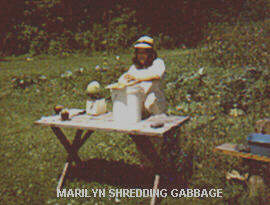18016 Church Road ~ Marengo IL 60152
Making sauerkraut is as easy as falling off a log but making good kraut and keeping it that way takes a little more effort. What follows is a method I use to produce consistantly good kraut, year after year and I have to date them to know which to eat first. The three year old tastes just like the 3 month old.
BACKGROUND
Like just about everything on these pages, Sauer Kraut is a product of fermentation. This totally changes the flavor of the raw material in addition to giving it long term keeping qualities. These days of course, we are interested only in the gastronomic aspects, as fresh cabbage is available the year round.
The sauerkraut fermentation process utilizes the indigenous population of bacteria in the raw cabbage to produce lactic acid. This produces a low pH environment that allows few if any other bacteria to survive. The lactic acid is also what gives the kraut it's characteristic sour flavor. Salt is added to the raw cabbage to draw out much of the water (drier product keeps longer) and to inhibit salt-intolerant bacteria. This allows the acid producing bacteria to get a strong foot hold and dominate the population.
The typical routine is to mix the cabage with salt and then let it sit in a vat or barrel for the 6 week fermentation period. It is then ready to eat. It can be taken out as needed but that is were much of the trouble starts. I highly recommend processing it in a canner or pressure cooker to prevent further change, which is usually is in the direction of spoilage or at least off-flavors.
The simple procedure which follows, eliminates all the problems by advancing to the optimum packaging stage earlier.
EASYKRAUT
You can make any amount you want but I find ten pounds, convenient. It fits into 5 gallon bucket and makes about all I can eat in a year (about 20 pints). I lose about 25% of my cabbage to triming so you must allow for that if you are buying it.
Shred it any way you like... food processor, knife, etc. We have an official Krauthobel my wife picked up in Germany that works very well, sitting on top of the bucket as in the picture. Weigh the shreded cabbage and add 2 tsp (12 gr) of pickling salt per pound. Mix this well and regularly. Initially, you have to get in there with your hands but as the water starts drawing out, it gets easier with a long spoon.
After 24 hours, prepare pint mason jars by washing thoroughly in hot soapy water. Mix the kraut again and begin filling the jars with a ladle, paying attention to the liquid/kraut balance. Stir before each jar to make sure that each jar gets its share of brine. After all the jars are filled to the usual 1" head space, top them off with remaining brine or tap water. Beware of chlorine here if you have to add a lot, it should be boiled first or use distilled water.
When the jars are filled and topped off, screw on the lids and place them in pans or trays to collect any over flow and store at room temp for 6 weeks. I turn them upside down a few times during the period just to mix things up but put them back the right way after a few turns. I get very little (if any) overflow. The fermentation process produces CO2 so there is some bubbling and leakage out the top but the jars are designed to deal with this and there is no danger of bursting.
When 6 weeks is over, open a jar and simmer it in a sauce pan for 5 minutes or so and taste it. If you like it (I always do), then you can process them for long term keeping. Before processing, you need to rinse the jars; then remove the lids and wipe both the jar top and seal of the lid with clean wet fingers to remove any gunk that would prevent a seal. Then process them in boiling water or a pressure cooker. I process mine for 10 minutes a 10 lbs.
That's all there is too it. You will never buy store stuff again.
PICKLED PSEUDO RED KRAUT
Simmer 1/4 lb fresh beets till soft enough to slip off the skins. Save the juice for later and cut, dice or leave whole as preferred.
Shred 2 lbs cabbage and add 4 tsp salt. Add the beets and let sit overnight to start fermentation and wilt.
Make a brine of:
1 cup vinegar
1 cup sugar
1/2 cup beet juice
Your choice of other spices... cloves, pickling etc.
Stir cabbage and beets and ladle into jars with perforated ladle, leaving most of the brine behind. Top off jars with the sweet brine, screw on lids and process at 10 lb for 10 min.
Great change from kraut and goes well with the same meats.
Bon appetit,
js
